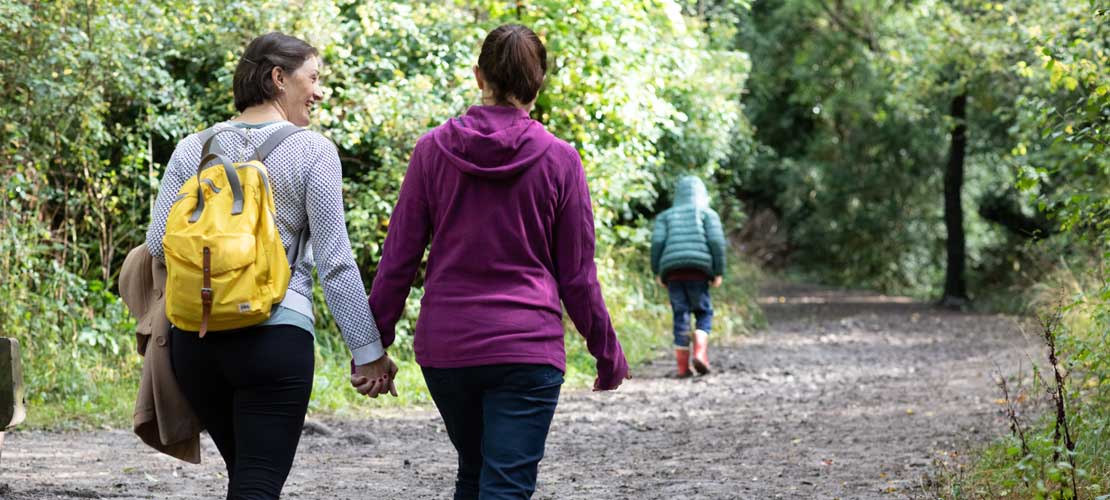Cross-party report hails health and wellbeing benefits of London Green Belt

4 November 2019
A new report by a cross-party Parliamentary group shows that London’s Metropolitan Green Belt not only protects against urban sprawl but also provides vital countryside on our doorstep for health and wellbeing benefits.
These benefits include:
- 26,267 hectares of Sites of Special Scientific Interest
- 5,400 hectares of local nature reserves
- 44% of London’s Wildlife Trust sites
- 10,000km of public rights of way for use by walkers, cyclists and horse riders
- An area of which one quarter (24%) is designated Areas of Outstanding Natural Beauty
- A new report by the All-Party Parliamentary Group for London’s Green Belt[1] shows that the London Metropolitan Green Belt (LMGB) not only protects against urban sprawl, it’s also the ‘countryside on our doorstep’, containing much of the capital’s natural reserves and wildlife, which is vital for Londoners to spend time in for their health and wellbeing.
The findings by the group of MPs in their report A Positive Vision for London’s Green Belt[2] show that the LMGB is home to public rights of way used by walkers and cyclists, Areas of Outstanding Natural Beauty, Wildlife Trust sites and open farmland – all of which provide important long-term benefit for all those living in, and around, the capital.
Findings highlight the value of ‘green-prescribing’ and the positive impact of the Green Belt on people’s mental health, physical well-being, local food production, and the capital’s ability to address the climate emergency, such as supporting the target’s set out in the Government’s 25 Year Environment Plan.
However, despite these benefits, research also shows that the purpose of London’s Green Belt is under threat from new housing development. There are well-advanced plans for 100,000 houses[3] – with more than double this number in the planning pipeline – yet ‘little evidence that any of these homes will be ‘affordable homes’ for key workers, young people and young families.’[4] This is despite the fact that there is space for well over 280,000 homes on previously developed brownfield land within Greater London alone[5].
The report recommends bold new measures to protect the Green Belt for those living in the capital:
- That an Advisory Council be set up to conduct a comprehensive review of the LMGB and create a 25-year strategy for its future, following the objectives as set out in the Government’s 25 Year Environment Plan
- Funding be provided on the same basis as that for National or Regional Parks, to improve the landscape, biodiversity, water retention, and the carbon sequestration abilities of the LMGB. to ensure it delivers multiple benefits for local communities
- That action be taken to ensure that everyone in and around London, and further afield, feels able to access the benefits of the countryside close at hand
- Review of the National Policy Planning Framework to ensure that the Green Belt is better protected from inappropriate development.
Crispin Blunt MP, Co-Chair of the All-Party Parliamentary Group (APPG) for London’s Green Belt, said:
‘The APPG for London’s Green Belt was set up in response to the rapidly increasing pressure for development on Green Belt Land that has escalated over the last few years and is now reaching a crisis point.
‘As a society, we have to decide whether or not we value the Green Belt sufficiently to prevent its erosion and subsequent disappearance in the coming decades. We have chosen to focus on the positive benefits of London’s Green Belt as we want these to complement its importance as the central defence against urban sprawl. Once Green Belt has been developed, it is impossible to get it back again.’
Tom Fyans, Deputy Chief Executive of CPRE, the countryside charity, said:
‘Green Belts provide a huge opportunity to help us in our efforts to address the climate emergency and wildlife crisis while supporting the improved health and well-being of people living and working in and around London, which is continually being ignored. Now is the time to take new and bold action to keep this valuable green resource for future generations.’
Richard Knox-Johnston, Chair of the London Green Belt Council, said: ‘Accessible open countryside adjoining urban London has a vital role to play in assisting in the climate emergency, improving health and wellbeing, giving opportunities for recreation and providing fresh and nutritious food close to the city centre.
‘At present, there is no overall organisation with responsibility for the use of land in London’s Green Belt which would be able to create a long-term strategy for its beneficial use and protection.
‘We need a clear vision and strategy for London’s Green Belt to ensure it can provide its important resource for those living and working in and around London.’
Parliament has been dissolved for the General Election, during this period there are no MPs and so the APPG for London’s Green Belt does not exist.
Notes to editors:
1. The All-Party Parliamentary Group for LMGB exists to advocate Green Belt friendly planning policies and contribute on the debate on how best to achieve sustainable development that protects LMGB for the benefit of future generations. The group is chaired by Crispin Blunt MP and its co-chare is Lord Rogers of Riverside.
2. For a copy of the report please see here.
3. Data taken from Space to Breathe: A State of the Green Belt Report, CPRE October 2019.
4. Summarised in the Annex and from ‘Safe Under Us?’ – Two Years On, London Green Belt Council, January 2019
5. State of Brownfield 2019, CPRE, March 2019.
For further information please call Media Relations Lead, Faith Mall, on 020 7981 2819 / 077 3933 2796.



